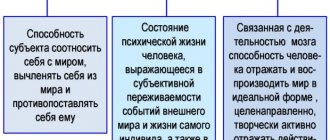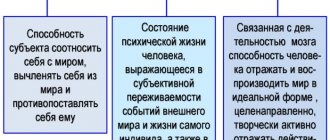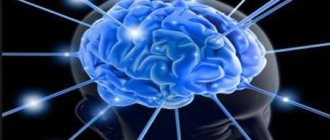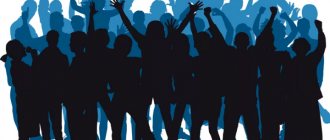A crowd is a chaotic, but still not devoid of a certain organization, large gathering of people. Most often it arises due to the fact that some circumstances, events, incidents, etc. attract mass attention. However, this is not the only thing that unites people in the crowd, because... The general mental state, tension, emotions, motives and other features come into force.
All this, including the behavioral reactions of social groups and individuals within them, is studied in a separate direction - crowd psychology. This article is dedicated specifically to her. We will try to consider the psychology of the crowd briefly, but as objectively as possible.
Crowd: definition and nature of its formation
For the first time, the famous French sociologist Gustave Le Bon tried to give a scientific explanation of the crowd phenomenon at the turn of the 19th and 20th centuries. His first articles on this topic were published in Revue Scientific in 1885, and then his book “The Psychology of Crowds” was published, after which the ideas began to gain popularity in scientific circles. The very problem of studying the crowd has become the object of attention of many scientists, including domestic ones (V. M. Bekhterev, G. M. Andreeva and others).
The concept of “crowd,” by the way, became part of social psychology when mass revolutionary unrest occurred in the world (again, this is the turn of the 19th and 20th centuries). For this reason, at first the crowd was understood as poorly organized protests of the proletariat against the ruling class.
Currently, psychology interprets the term “crowd” as follows: a crowd is an unstructured and unorganized collection of people united by a single object of attention and the same feelings regarding it. One of the hallmarks of a crowd is the absence (or loss) of a conscious and clear common goal.
A classic example of a crowd in social psychology is a crowd of people during any transport accidents, mass events, pickets, protests, rallies, natural disasters, military exercises, etc.
Surely you yourself have been a member of a crowd or observed this phenomenon at least once in your life. Actually, it is simply impossible to ignore the so-called crowd effect, because people who find themselves in a crowd almost instantly convey its mood and behavioral reactions. They join this mass and become part of it, even if this goes against their own principles and desires.
The behavior of a crowd can be very unpredictable, and its mood can pose a potential threat to individuals and society as a whole, as well as to the infrastructure of populated areas (organizations, buildings, cultural objects, etc.) By the nature of the formation of a crowd, it can be quite easily determined compound. Typically the crowd consists of:
- Instigators . This is the core of the crowd. It is made up of people who form it, competently and correctly configure it and use it for specific purposes.
- Participants . These are people who have joined the crowd and take an active part in its actions. Easily suggestible and sympathetic people (with a heightened sense of justice), ordinary people and people who do not have a specific goal for their current actions can be influenced by the crowd. Let us note that the latter category often contributes to the creation of mass participation, but does not take active part in the activities of the crowd. The most dangerous participants are people who use the crowd to splash out negative energy, anger, and aggression.
Gustave Le Bon's research made enormous contributions to crowd psychology. It is largely thanks to them that this scientific direction today identifies two main mechanisms of its formation. The first is the growing emotional contagion, and the second is rumors. The process of crowd formation itself occurs in several stages:
- Formation of the core of the crowd . Despite the fact that a crowd arises spontaneously, its formation is impossible without a core. Such a core may be instigators who are aware of their actions and pursuing specific goals, or some event (incident). Then banal curiosity begins to act, attracting even more people to the center. Interest leads to the fact that people join the crowd, and there can be any number of such “infusions”, and each of them fuels emotions, which is why people are attracted again and again.
- Whirling . When a crowd has formed, tension begins to accumulate within it, which is why people’s perception of any external influences intensifies. A circular reaction occurs and the excitement becomes stronger. This leads to the fact that the entire mass of people is ready to react with lightning speed to incoming information.
- The emergence of a new object of attention . The processes occurring within the crowd (gossip, gossip, conversations fueled by the intensity of feelings) change the reason that served as the source of the crowd, i.e. core. The image created by the people themselves from the crowd comes into play. Everyone accepts it, and therefore it captures people’s attention and feelings, and also sets the direction for further actions.
- Activating individuals . As one might expect, the tension accumulated within the crowd requires release. It is achieved through additional stimulation of crowd participants. To do this, their imagination is fueled and suggestion is made. The result is certain actions of people, and they may well defy logic and be unsafe. The instigators or a specific leader add fuel to the fire. In this way they strive to achieve their goal.
It is important to note that an already formed crowd can be very dangerous, especially if it is controlled (and contained within) by aggressive people. The consequences of the actions of such a crowd can be the most destructive. It is extremely difficult to curb an uncontrollable crowd. But let's not exaggerate, but watch a short video about how the behavior of even a small number of people can affect the behavior of one person.
What is a crowd, group and riots from the point of view of social psychology: briefly
Crowd, group, riots
A crowd is a collection of people who are emotionally excited and have direct contact with each other. The main distinguishing feature of a crowd is its spontaneous formation, as well as the lack of conscious common goals among people.
When interpreting the concept of “group ,” psychology primarily relies on interdisciplinarity, that is, on the sociological as well as the psychological paradigm. Understanding group psychology and social psychology occurs through analysis that examines the social groups being tested, identifying the details that turn them into a psychological community. In turn, it allows any individual person to identify with a certain group.
From the point of view of social psychology, the basis for mass unrest can be various reasons. For example:
- Policy
- National discord
- Provocations
- Protests
As a rule, riots arise spontaneously, due to unexpected circumstances. Their main psychological feature is the large number of people taking part in them. At the same time, it is necessary to take into account the fact that the psychology of a person caught in a crowd is sharply distorted, especially at the time of an extreme situation, when the mind is exposed to strong factors. This state of a person is called “Crowd Psychology” , and is caused by blindly following the general mass. This is the main driving force behind all riots.
Crowd types
After we have briefly examined the main characteristics of a crowd and the features of its formation, it’s time to talk about what types of crowds exist. The psychology of masses cannot be considered as something unchanging, and further you will understand why. The crowd can be divided into types according to various criteria.
The first sign is controllability, and the crowd may be:
- Spontaneous - when its formation and manifestations occur on their own and no one controls it.
- Followed - when it is formed and directed by a specific leader.
The second sign of a crowd is behavioral reactions, and a crowd can be:
- Occasional - its basis is interest in some reason (event, incident) that arose spontaneously. Such a reason could be a fight, an emergency, a fire, etc.
- Conventional - formed due to interest in any mass event (concert, sports match, etc.) Such events are usually planned in advance, announced, advertised and expected by people. A conventional crowd can be controlled because... it operates within the given regulations. But control is always temporary, and the regulations themselves do not have clear boundaries.
- Expressive - where people unite due to the same attitude towards events or incidents (rejoice, condemn, protest, indignant, etc.) This type can also include an ecstatic crowd, the excitement of the participants is transformed into ecstasy. Such crowds can be observed at concerts, carnivals, and during religious events that plunge people into euphoria.
- Acting - formed through emotional unity. This type of crowd is either already taking specific actions or preparing for them.
The active crowd, in turn, can also be divided into several types:
- Acquisitive - participants are united by the struggle for material values, such as goods, money, food, seats in public places, etc. This type of crowd can form during discount promotions, new products going on sale, product shortages, rush hours, bankruptcy of financial institutions, natural disasters, catastrophes and terrorist attacks.
- Panic - participants are united by mass panic, motivating them to escape from danger. People's panic can be associated either with a real (evacuation notice, etc.) or with an imaginary (rumors of a terrorist attack, etc.) threat.
- Aggressive - participants are united by aggression directed at a specific object. Thus, people can hate a specific person, a race of people, a subculture, a social movement, a structure, etc.
- Insurgent - participants are united by dissatisfaction and indignation with the work of state structures and the government. Such crowds often become a powerful weapon in political struggle.
The variability of the crowd determines its characteristics such as instability of structure, presence, absence and clarity of goals. Therefore, one type of crowd (as well as a subtype) can easily turn into another. So crowd control (including crowd decontamination) requires an accurate understanding of the intricacies of crowd formation and behavior. For the same purposes, as well as for general development and your own safety, you also need to know the psychological properties of the crowd, which will be discussed later in the article.
Factors influencing crowds
An important factor in crowds is race. She needs to constantly maintain intellectual connectedness and emotional persuasion. Race has the power to transform ideas or needs into traditions. From here she is able to transmit these traditions to another race.
“People of all races worship one deity, calling him by different names - hope. After all, all their gods were one and only god,” wrote Le Bon. Litvak believes that hope must be killed. I agree with him, because when there is no hope, a person will listen to reason.
Another important factor is the use of formulas and certain words. The more vague the word or expression, the greater the influence. Words such as equality, socialism, democracy, freedom are perceived by the crowd as if the solution to all problems depends on them
Psychological properties of the crowd
The psychology of the masses is explained by a whole complex of features that are characteristic of large crowds of people. These features relate to the most important areas of a person’s personality: cognitive, moral, emotional-volitional and temperamental. Let's look at them briefly.
In the cognitive sphere we can distinguish the following properties:
- Infectivity and suggestibility. People in a crowd easily pick up on the general mood and are overly susceptible to suggestion. It is extremely easy to introduce a certain idea or image into their consciousness.
- Lack of awareness. Reason and logic are completely alien to the crowd. She is ruled by emotions. Even in ordinary life, people do not always think rationally, let alone situations when they succumb to the herd instinct. In a crowd, the unconscious begins to dominate the conscious.
- Imaginative thinking. In large and spontaneous crowds, people think figuratively - their thinking is extremely simplified. Because of this, subjective information ceases to differ from objective information, people do not perceive complex ideas, lose the ability to reason, discuss, delve into details and make choices. It turns out that events can only develop this way: the crowd either completely accepts the idea or rejects it. And, which is typical, more often people choose not truth and reality, but misconceptions and illusions.
- Conservatism and categoricalness. Any crowd is always attached to traditions (country, society, subculture, etc.) and negatively perceives any deviations and innovations. In addition, the judgments that she accepted (or were inspired by them) are not subject to any doubts or modifications.
- Stimulation of imagination. People in the crowd begin to share not only common emotions, but also images. Due to increased sensitivity, any information in their minds becomes extremely vivid. The mass imagination operates in such a way that all events are seriously distorted (but this is also influenced by the way in which they are presented to the crowd).
Now let's touch on the moral sphere. Here, the psychology of the masses is manifested in the fact that the crowd actively demonstrates sublime feelings, such as selflessness, a sense of justice, devotion, religiosity (by the way, the latter is very important, because it requires complete submission, intolerance and propaganda), etc.
We can also add here that the crowd influences all its participants in such a way that they lose their personality, becoming faceless “cogs in the mechanism”, controlled only by their instincts. A person in a crowd is suppressed by his environment, and the interests of this environment become more important than his own. As a result, he begins to gravitate toward arbitrariness and aggression, begins to feel impunity and permissiveness, and degrades intellectually and behaviorally.
A little more can be said about the emotional-volitional sphere. Here the following properties come into force:
- Increased sensitivity. Due to reduced responsibility and hypersensitivity, strong unidirectional impulses appear in the crowd (they are shared by every member of the crowd). It does not matter whether the impulses are positive or negative, but the feelings experienced by people go to extremes. And not only a person’s own interests and rationalism, but also his instinct of self-preservation recede into the background.
- Weak motivation. Despite the enthusiasm with which people in a crowd perceive events and ideas, their interest is short-lived and unstable. This can explain the lack of will and lack of prudence.
- Lack of responsibility. People in the crowd, as we said, feel impunity and permissiveness, which means they do not think at all about responsibility for their actions and deeds. Moreover, it is this irresponsibility that makes people very cruel.
- Emotionality. Emotional resonance is one of the most striking behavioral properties of a crowd. Participants constantly exchange emotions with each other, the emotional charge, constantly being fed, reaches its climax, and it becomes almost impossible to control the manifestations of the crowd.
- Extremism. In the overwhelming majority of cases, a crowd is considered a destructive phenomenon, i.e. destructive. Passions and instincts hidden in ordinary life somewhere in the hidden corners of consciousness are released. This is why it is so common to see people in the crowd reacting violently to every obstacle in their path.
As for the sphere of temperament, here we can only say that people in a crowd can adopt each other’s temperamental traits with incredible speed, but at the same time the perception of images and ideas always remains inconsistent. Also in this regard, the crowd is different in that it is ready to take action at any moment. And at this point it would be appropriate to move on to the final block of the article, devoted to the actions of the crowd. But we will consider not the options for her actions, but how these actions can be controlled.
Spiritual unity
Many researchers whose subject of study is the psychology of the masses agree that the crowd is an unorganized society. Its main characteristic has always been spiritual unity. In this case, it can be compared to something like a highly contagious infectious disease. The main “symptom” of the disease is a state of passion, which, at the time of a strong emotional outburst, spreads at high speed.
As an exception that confirms the above rule, we can consider a crowd that was formed as a result of the unification of people who have a similar way of thinking. Only like-minded people will be able to integrate, and not all those who have been infected by a common emotional state.
A feature of any group, especially an aggressive one, is categorical beliefs and conservatism. They can also be regarded as the foundation for spiritual unity. Based on the fact that the crowd is absolutely confident in the correctness of the line drawn between truth and error, it is characterized by intolerance.
How to control a crowd
Naturally, we will not consider all the intricacies of managing mass consciousness in one article, but you can still briefly study this issue (in general, we recommend reading books on the topic of crowd psychology - at the end we will offer a small list of them).
The behavior of the crowd is influenced by various factors, including the events taking place, their direction and speed, the psychological state of people in the crowd, ideological influences, the form of their presentation, prejudices, illusions, superstitions and much more.
We have already said that initially the crowd is uncontrollable and spontaneous, but still it will strive to obey the will of others. The leader she will listen to may arise spontaneously, or take control over her of his own free will. But such subtleties do not matter to the crowd, and they will obey in any case.
The peculiarity of the crowd is that it is unquestioning, blind and instinctive in its submission, and also in the fact that it will reject a weak leader and bow to a strong one. It is possible and necessary to control a crowd harshly, and it is precisely this kind of power that serves as the most effective control tool for them.
However, to control a crowd, a person must have a set of special skills and qualities. Let's name the most important of them:
- Charm. A leader must be charming and charismatic, and it does not matter what serves as the basis for charm and charisma - admiration for a person or fear of him, success in any field, wealth or skillful use of psychological methods of influence. The main thing is that the crowd perceives the leader and listens to him.
- Mastery of crowd control techniques. Any competent leader must understand that achieving power over the crowd involves going through several stages. Initially, you need to infiltrate the crowd, then understand what worries them and how they live, then gain trust and convince them that you share their interests, and only after that make attempts to control. Plus, the leader needs to understand the mechanisms of formation and “work” of the crowd.
- Activity. A person leading a crowd always acts and does not think. To do this, he uses energy or willpower that allows him to do what others do not do.
- Ideology. The most important goal of a leader is to develop an idea and sow its seeds in the public consciousness. If we look at history (watch documentaries or read books), we will see that very often at the pinnacle of power there are people with beliefs that simply cannot be refuted or challenged, even if they are absurd, ridiculous or terrifying.
- Oratorical skills. A strong and authoritative person must realize that the crowd understands only direct, loud and strong phrases. At the same time, it is necessary to use different speech techniques: statements, repetitions, exaggerations, etc.
An interesting fact is that crowd control almost always has a dual character: on the one hand, it is controlled by the leader, and on the other, by the power structures. The tasks of these parties are different: if the first uses the crowd to achieve a goal, then the second seeks to disband the crowd. To do this, security forces use special methods, for example, diverting people's attention to separate them, depriving them of a leader, or awakening reason. But this is a topic for another article, so let’s summarize.
A crowd is capable of exerting a serious influence on the people within it, strangers, political processes, and the life of society and the state. This is the main reason why many leaders (including political ones) often resort to using the crowd. But ordinary people, who are capable of becoming part of the crowd at any moment, must know the psychology of the masses and apply this knowledge in life. At a minimum, to have a general understanding of the crowd and the behavior of people in it, and at a maximum, to know how a crowd can influence consciousness, and to be able to protect oneself if necessary.
And, as we promised, here is a small list of books on crowd psychology that are worth reading:
- Gustave Le Bon “Psychology of Nations and Masses”;
- Scipio Siegele “Criminal Crowd. Experience of collective psychology";
- Serge Moscovici "The Age of Crowds" Historical treatise on mass psychology";
- A. V. Zabarin “Psychology of crowds and riots”;
- L. G. Pochebut “Social psychology of the crowd”;
- D. Ya. Raigorodsky “Psychology of the masses”;
- A. P. Nazaretyan “Aggressive crowd, mass panic, rumors”;
- G. M. Andreeva “Social psychology”;
- V. M. Bekhterev “Suggestion and the Crowd.”
And, since we ended the conversation with personal safety, we invite you to watch a video specifically on this topic. We wish you good health and the ability to always maintain the ability to think soberly and independently!
Did you like the article? Join our communities on social networks or our Telegram channel and don’t miss the release of new useful materials: TelegramVKontakteFacebook
We also recommend reading:
- Storytelling
- Attributes of a Great Man
- The ability to stand out from the crowd using the PVI method
- Criminal psychology
- Group polarization
- Neuromarketing
- How to pump up your creative muscles. 50 Shades of Creativity: Infographic
- Mass consciousness in practice
- Secrets of charisma during public speaking (part 2)
- Ways to be more creative
- Marina Abramovic's experiment: unknown boundaries of the possible...
Key words:1Communication
Psychology of the crowd. Or the secret of crowd control
What is a crowd?
Psychology of the crowd. Or the secret to controlling the masses.
1. The concept of a crowd. What is a crowd?
The idea of a crowd usually comes from people's personal experiences. Almost everyone has either been in a crowd or seen its behavior from the outside. Sometimes, succumbing to simple human curiosity, people join a group viewing and discussing some event. Growing in numbers, becoming infected with the general mood and interest, people gradually turn into a discordant, disorganized aggregation, or crowd.
A crowd is an unstructured accumulation of people, devoid of a clearly recognized commonality of goals, but mutually connected by the similarity of their emotional state and a common object of attention.
The term “crowd” entered social psychology during the period of powerful revolutionary upsurge of the masses at the end of the 19th and beginning of the 20th centuries. By a crowd, psychologists at that time understood mainly weakly organized actions of workers against the exploiters.
The crowd as a subject of mass forms of non-collective behavior often becomes:
- public, which is understood as a large group of people arising on the basis of common interests, often without any organization, but always in a situation that affects common interests and allows for rational discussion;
- a contact, outwardly disorganized community, acting extremely emotionally and unanimously;
- a collection of individuals who make up a large amorphous group and for the most part do not have direct contacts with each other, but are connected by some common more or less constant interest. These are mass hobbies, mass hysteria, mass migrations, mass patriotic or pseudo-patriotic frenzy.
Psychology of the crowd. Or the secret to controlling the masses.
In mass forms of non-collective behavior, unconscious processes play a large role. Based on emotional arousal, spontaneous actions arise in connection with some impressive events that affect the main values of people during, for example, their struggle for their interests and rights.
Even the main stages of crowd formation have been defined:
Formation of the core of the crowd.
The initial core of the crowd may be formed under the influence of rationalistic considerations and set itself very specific goals. But later the core grows like an avalanche and spontaneously. The crowd grows, absorbing people who, it would seem, had nothing in common with each other before. A crowd is spontaneously formed as a result of some incident that attracts the attention of people and gives rise to interest in them (more precisely, at the very beginning - curiosity). Excited by this event, the individual who has joined those already assembled is ready to lose some of his usual self-control and receive exciting information from the object of interest. A circular reaction begins, encouraging those gathered to express similar emotions and satisfy new emotional needs through psychic interaction.
Circular reaction constitutes the first stage of the formation and functioning of the crowd. The whirling process. The second stage begins simultaneously with the whirling process, during which the senses become even more acute and there is a readiness to respond to information coming from those present. The internal whirling based on the ongoing circular reaction increases. Excitement also increases. People are predisposed not only to joint, but also to immediate action.
The emergence of a new common object of attention. The circling process prepares the third stage of crowd formation. This stage is the emergence of a new common object of attention on which people's impulses, feelings and imagination are focused. If initially the common object of interest was an exciting event that gathered people around it, then at this stage the new object of attention becomes the image created in the process of circling in the conversations of crowd participants. This image is the result of the creativity of the participants themselves. It is shared by everyone, gives individuals a common orientation and acts as an object of joint behavior. The emergence of such an imaginary object becomes a factor that unites the crowd into a single whole.
Activation of individuals through excitement. The last stage in the formation of a crowd is the activation of individuals through additional stimulation through the excitation of impulses corresponding to an imaginary object. Such (suggestion-based) stimulation most often occurs as a result of the leadership of a leader. It encourages the individuals who make up the crowd to take specific, often aggressive, actions. Among those gathered, instigators usually stand out, who initiate active activity in the crowd and gradually direct its behavior. These may be politically and mentally immature and extremist-minded individuals. Thus, the composition of the crowd is clearly defined.
The core of the crowd, or instigators, are subjects whose task is to form a crowd and use its destructive energy for their intended purposes. It is these people who master the psychology of the crowd or the secret of crowd control.
Crowd participants are subjects who joined it as a result of identifying their value orientations with the direction of the crowd’s actions. They are not instigators, but they find themselves in the sphere of influence of the crowd and actively participate in its actions. A particular danger is posed by aggressive individuals who join the crowd solely because of the opportunity to release their neurotic, often sadistic, inclinations.
Among the crowd members are also those who are conscientiously mistaken. These subjects join the crowd due to an erroneous perception of the situation; they are driven, for example, by a falsely understood principle of justice.
Common people join the crowd. They don't show much activity. They are attracted to excess as an exciting spectacle that diversifies their boring, dull existence.
Highly suggestible people who succumb to the general infectious mood find a place in the crowd. Without resistance, they surrender to the power of natural phenomena.
Participants in the crowd also include simply curious people, watching from the sidelines. They do not interfere in the course of events, but their presence increases the mass character and enhances the influence of the element of the crowd on the behavior of its participants.
2. Crowd classification
Like any other social phenomenon, a crowd can be classified on various grounds. If we take such a feature as controllability as the basis for the classification (this is one important secret of crowd control), then we can distinguish the following types of crowds.
Spontaneous crowd. It is formed and manifested without any organizing principle on the part of a specific individual.
Driven crowd. It is formed and manifested under the influence, influence from the very beginning or subsequently of a specific individual who is its leader in a given crowd.
Organized crowd. This variety is introduced by G. Le Bon, considering as a crowd both a collection of individuals who have embarked on the path of organization and an organized crowd. We can say that he sometimes does not make a difference between an organized and an unorganized crowd. Although it is difficult to agree with this approach. If a community of people is organized, it means that it has structures of management and subordination. This is no longer a crowd, but a formation. Even a squad of soldiers, as long as it has a commander, is no longer a crowd.
If we take the behavior of people in it as a basis for classifying a crowd, we can distinguish several types and subtypes.
Occasional crowd. Formed on the basis of curiosity about an unexpected incident (road accident, fire, fight, etc.).
Conventional crowd. Formed on the basis of interest in any pre-announced mass entertainment, spectacle or other socially significant specific occasion. I am only willing to temporarily follow rather diffuse norms of behavior.
Expressive crowd. It is forming, just like a conventional crowd. It jointly expresses the general attitude towards any event (joy, enthusiasm, indignation, protest, etc.)
Ecstatic crowd. Represents an extreme form of expressive crowd. It is characterized by a state of general ecstasy based on mutual rhythmically increasing infection (mass religious rituals, carnivals, rock concerts, etc.).
Crowd at a rock concert
Active crowd. It is formed - just like the conventional one; carries out actions regarding a specific object. The current crowd includes the following subspecies.
1. Aggressive crowd. United by blind hatred of a specific object (any religious or political movement, structure). Usually accompanied by beatings, pogroms, arson, etc.
2. Panic crowd. Spontaneously fleeing from a real or imaginary source of danger.
3. The money-grubbing crowd. Enters into a disorderly direct conflict for the possession of any values. It is provoked by authorities who ignore the vital interests of citizens or encroach on them (the storming of places in outgoing transport, the frantic grabbing of products in trade enterprises, the destruction of food warehouses, the siege of financial (for example, banking) institutions, in small quantities it manifests itself in places of major disasters with significant human casualties victims, etc.).
4. Rebel crowd. It is formed on the basis of general fair indignation at the actions of the authorities. The timely introduction of an organizing principle into it can elevate a spontaneous mass action to a conscious act of political struggle.
3. Psychological properties of the crowd
Social psychologists note a number of psychological characteristics of the crowd.
Failure to be aware. Important psychological characteristics of the crowd are its unconsciousness, instinctiveness and impulsiveness. If even one person is rather weakly amenable to the messages of reason, and therefore does most of his actions in life thanks to emotional, sometimes completely blind, impulses, then the human crowd lives exclusively by feeling, logic is contrary to it. An uncontrollable herd instinct comes into play, especially when the situation is extreme, when there is no leader and no one shouts restraining words of command. The heterogeneous in each of the individuals - a particle of the crowd - is buried in the homogeneous, and unconscious qualities take over. General qualities of character, controlled by the unconscious, are united together in a crowd. An isolated individual has the ability to suppress unconscious reflexes, while a crowd does not have this ability.
Features of thinking. The crowd thinks in images, and the image evoked in its imagination, in turn, evokes others that have no logical connection with the first. The crowd does not separate the subjective from the objective. She considers as real images evoked in her mind and often having only a very distant connection with the fact she observes. The crowd, capable of thinking only in images, is receptive only to images.
Crowd
The crowd does not reason or think. She accepts or rejects ideas entirely. She does not tolerate any disputes or contradictions. The reasoning of the crowd is based on associations, but they are connected to each other only by apparent analogy and consistency. The crowd is capable of perceiving only those ideas that are simplified to the extreme. The judgments of the crowd are always imposed on them and are never the result of full discussion.
Categorical. Without any doubt as to what is truth and what is error, the crowd expresses the same authority in its judgments as intolerance.
Conservatism. Being fundamentally extremely conservative, the crowd has a deep aversion to all innovations and experiences boundless reverence for traditions.
Suggestibility. Freud put forward a very productive idea to describe the phenomenon of crowds. He viewed the crowd as a human mass under hypnosis. The most dangerous and most significant thing in crowd psychology is its susceptibility to suggestion.
Any opinion, idea or belief instilled in the crowd is accepted or rejected entirely and treats them either as absolute truths or as absolute errors.
In all cases, the source of suggestion in the crowd is an illusion born in one individual thanks to more or less vague memories. The evoked idea becomes the nucleus for further crystallization, filling the entire area of the mind and paralyzing all critical faculties.
Infectivity. Psychological contagion contributes to the formation of special properties in the crowd and determines their direction. Man is prone to imitation. Opinions and beliefs are spread to the crowd through contagion.
The emotional-volitional sphere of the crowd is also characterized by numerous psychological features.
Emotionality. In a crowd, there is such a socio-psychological phenomenon as emotional resonance. People involved in excesses are not just next to each other. infect others and become infected themselves from them. The term “resonance” is applied to this phenomenon because crowd participants, when exchanging emotional charges, gradually intensify the general mood to such an extent that an emotional explosion occurs, which is difficult to control by consciousness. The onset of an emotional explosion is facilitated by certain psychological conditions of individual behavior in a crowd.
High sensuality. The feelings and ideas of the individuals who form the whole called the crowd take one and the same direction. A collective soul is born, which, however, is of a temporary nature. The crowd knows only simple and extreme feelings.
The various impulses to which the crowd obeys may, depending on the circumstances (namely, the nature of the excitement), benevolent or evil, heroic or cowardly, but they are always so strong that no personal interest, not even a sense of self-preservation, can suppress them.
The strength of the crowd's feelings is further increased by the lack of responsibility. Confidence in impunity (all the stronger, the larger the crowd) and the consciousness of significant (albeit temporary) power make it possible for crowds of people to show such feelings and perform such actions that are simply unthinkable and impossible for an individual.
Whatever the feelings of the crowd, good or bad, their characteristic feature is one-sidedness. The one-sidedness and exaggeration of the feelings of the crowd lead to the fact that it knows neither doubts nor hesitations.
In its eternal struggle against reason, feeling has never been defeated.
Extremism. The forces of the crowd are aimed only at destruction. Instincts of destructive ferocity lie dormant in the depths of the soul of almost every individual. Giving in to these instincts is dangerous for an isolated individual, but being in an irresponsible crowd, where he is guaranteed impunity, he can freely follow the dictates of his instincts. In the crowd, the slightest bickering or contradiction on the part of any speaker immediately provokes furious screams and violent curses. The normal state of a crowd that encounters an obstacle is rage. The crowd never values its life during a riot.
Motivation. Self-interest is very rarely a powerful motive force in a crowd, while in the individual it comes first. Although all the desires of the crowd are very passionate, they still do not last long, and the crowd is just as little capable of showing persistent will as it is of prudence.
Irresponsibility. It often gives rise to incredible cruelty of an aggressive crowd, incited by demagogues and provocateurs. Irresponsibility allows the crowd to trample the weak and bow before the strong.
4. Psychological characteristics of an individual in a crowd
In a crowd, an individual acquires a number of specific psychological characteristics that may be completely unusual for him if he is in an isolated state. These features have a direct impact on his behavior in the crowd.
A person in a crowd is characterized by the following traits.
Anonymity. An important feature of an individual’s self-perception in a crowd is the feeling of one’s own anonymity. Lost in the “faceless mass,” acting “like everyone else,” a person ceases to be responsible for his own actions. Hence the cruelty that usually accompanies the actions of an aggressive crowd. A member of the crowd appears to be anonymous in it. This creates a false sense of independence from the organizational ties by which a person, wherever he is, is included in the work collective, family and other social communities.
Instinctivity. In a crowd, an individual gives himself over to instincts that he never gives free rein to in other situations. This is facilitated by the anonymity and irresponsibility of the individual in the crowd. His ability to rationally process perceived information decreases. The capacity for observation and criticism that exists in isolated individuals disappears completely in a crowd.
Aggressive crowd
Unconsciousness. The conscious personality disappears and dissolves in the crowd. The predominance of the unconscious personality, the same direction of feelings and ideas determined by suggestion, and the desire to immediately transform inspired ideas into action are characteristic of the individual in the crowd.
A state of hypnotic trance. An individual, having spent some time among the active crowd, falls into a state that resembles the state of a hypnotized subject. He is no longer aware of his actions. In him, as in a hypnotized person, some abilities disappear, while others reach an extreme degree of tension. Under the influence of the suggestion acquired in the crowd, the individual performs actions with uncontrollable swiftness, which also increases, since the influence of the suggestion, the same for everyone, is increased by the power of reciprocity.
A feeling of irresistible strength. An individual in a crowd acquires the consciousness of an irresistible force due to sheer numbers. This consciousness allows him to succumb to hidden instincts: in a crowd he is not inclined to curb these instincts precisely because the crowd is anonymous and is not responsible for anything. The sense of responsibility, which usually restrains individuals, completely disappears in the crowd - here the concept of impossibility does not exist.
Infectivity. In a crowd, every action is contagious to such an extent that the individual very easily sacrifices his personal interests to the interests of the crowd. Such behavior is contrary to human nature itself, and therefore a person is capable of it only when he is part of the crowd.
Amorphous. In a crowd, the individual traits of people are completely erased, their originality and personal uniqueness disappear.
Irresponsibility. In a crowd, a person completely loses his sense of responsibility, which is almost always a limiting factor for an individual.
Social degradation. Becoming a part of the crowd, a person seems to fall several steps lower in his development. In an isolated situation - in ordinary life he was most likely a cultured person, but in a crowd - he is a barbarian, i.e. an instinctive creature. In a crowd, an individual exhibits a tendency toward arbitrariness, violence, and ferocity. A person in a crowd also experiences a decrease in intellectual activity.
5. Crowd behavior.
The behavior of the crowd reveals both ideological influences, with the help of which certain actions are prepared, and changes in mental states that occur under the influence of any specific events or information about them. In the actions of the crowd, there is a junction and practical implementation of influences, both ideological and socio-psychological, and their interpenetration into the real behavior of people.
The climate of mass hysteria serves as the background against which the most tragic actions often unfold.
As already mentioned, one type of crowd behavior is panic. Panic is an emotional state that arises as a result of either a lack of information about some frightening or incomprehensible situation, or its excessive excess and manifests itself in impulsive actions.
Factors that can cause panic are varied. Their nature can be physiological, psychological and socio-psychological. There are known cases of panic in everyday life as a consequence of disasters and natural disasters. When people panic, they are driven by unaccountable fear. They lose self-control, solidarity, rush about, and do not see a way out of the situation.
Factors that have a particularly strong influence on crowd behavior are the following.
Superstition is a firmly established false opinion that arises under the influence of fear experienced by a person. However, there may be a superstitious fear, the reasons for which are not realized. Many superstitions involve believing in something. They affect a variety of people, regardless of their level of education and culture. For the most part, superstition is based on fear and it intensifies many times over in a crowd.
Illusion is a type of false knowledge entrenched in public opinion. It may be the result of deception of the sense organ. In this context, we are talking about illusions related to the perception of social reality. Social illusion is a kind of ersatz resemblance to reality, created in a person’s imagination in place of genuine knowledge, which for some reason he does not accept. Ultimately, the basis of illusion is ignorance, which can produce the most unexpected and undesirable effects when manifested in a crowd.
Prejudice is false knowledge that has turned into belief, or more precisely, into prejudice. Prejudice is active, aggressive, assertive, and desperately resists genuine knowledge. This resistance is so blind that the crowd will not accept any argument contrary to prejudice.
6. Leader in the crowd and the secret of crowd control.
Often the behavior of a crowd is determined by the presence or absence of a leader. A leader in a crowd may appear as a result of a spontaneous choice, and often as a self-appointment. A self-proclaimed leader usually adapts to the moods and feelings of the people in the crowd and can relatively easily induce its participants to behave in a certain type.
Any collection of individuals instinctively submits to the authority of the leader. The hero whom the crowd worships is truly a god for them. In the soul of the crowd, it is not the desire for freedom that prevails, but the need for submission. The crowd is so eager to obey that it instinctively submits to the one who declares himself its ruler.
People in a crowd lose their will and instinctively turn to the one who has preserved it. Always ready to rebel against a weak government, the crowd subserviently and bows before the strong government. Left to their own devices, the crowd soon tires of its own riots and instinctively strives for slavery.
The crowd is as intolerant as it is trusting of authority. She respects strength and is little influenced by kindness, which for her only means a kind of weakness. She demands strength and even violence from the hero, she wants to be owned and suppressed. She longs to be afraid of her master. The power of the leaders is very despotic, but it is this despotism that forces the crowd to obey.
In a crowd of people, the leader is often only the leader, but, nevertheless, his role is significant. His will is the nucleus around which opinions crystallize and unite. The role of leaders is mainly to create faith, no matter what kind. This explains their great influence on the crowd.
Most often, the leaders are mentally unbalanced people, half-crazy, on the verge of madness. No matter how absurd the idea they proclaim and defend, and the goal towards which they strive, their convictions cannot be shaken by any arguments of reason. There is one more quality that usually distinguishes the leaders of the crowd: they are not thinkers - they are people of action.
Crazy leader
The leader class is divided into two categories:
- people are energetic, with a strong will that appears in them only for a short time;
- people with a strong and at the same time persistent will (they are much less common).
The secret of crowd control, which determines the influence of a leader on the crowd, is his charm. Charm is a type of dominance of an idea or personality over the mind of an individual. It can consist of opposing feelings, for example, admiration and fear, and can be of two types: acquired and personal. Personal charm is different from artificial or acquired and does not depend on title or power. It is based on personal superiority, on military glory, on religious fear, but not only on this. The nature of charm involves many different factors, but one of the most important has always been and remains success.
Controlling a crowd has a dual nature, because the crowd is almost always the object of control by two forces: on the one hand, it is led by leaders, leaders; on the other hand, the crowd is dealt with by public order forces and administrative authorities.
The possibilities of crowd control vary significantly depending on who strives to be a leader in it - a demagogue or an intellectual. As they say in the East, the one who wants to control the crowd is trying to ride the tiger. However, managing individuals is much more difficult than managing a crowd.
The mechanisms of mass behavior can be used by politicians with any views and any moral level. In such cases, the crowd becomes a toy in the hands of the leader. Typically, people who want to lead a crowd intuitively know how to influence it. They know that in order to convince a crowd, you must first understand what feelings inspire them, pretend to share them, and then conjure up in the crowd’s imagination images that seduce them. The crowd should always present any ideas in solid images, without indicating their origin.
A speaker who wants to captivate a crowd must overuse strong expressions. Exaggerating, asserting, repeating and never trying to prove anything by reasoning are the methods of argumentation for the crowd.
A statement only has an impact on the crowd when it is repeated many times in the same expressions: in this case, the idea is implanted in the minds so firmly that it is finally perceived as a proven truth, and then crashes into the deepest regions of the unconscious. This technique is also quite successfully used by leaders or leaders of the crowd.
A theoretical analysis of the mechanisms of crowd formation can to some extent help administrative authorities control crowd behavior. They face a twofold task:
1) awaken the crowd’s awareness of their actions, restore to them the lost sense of self-control and responsibility for their behavior;
2) prevent the formation of a crowd or disband an already formed crowd.
The following can be considered effective:
- reorienting the attention of the individuals who make up the crowd. As soon as the attention of people in a crowd is distributed among several objects, separate groups immediately form, and the crowd, just united by the “image of the enemy” or readiness for joint action, immediately disintegrates. The traits of the personal structure of individuals, suppressed by the influence of the crowd, come to life - each person individually begins to regulate his behavior. The crowd ceases to be active, functioning and gradually disperses;
- an announcement over the loudspeaker that hidden cameras are filming crowd members;
- addressing crowd members with the names of specific surnames, first names, patronymics, the most common in the area;
— application of measures to capture and isolate crowd leaders. If, by some accident, the leader disappears and is not immediately replaced by another, the crowd again becomes a simple gathering without any connection or stability. In this case, it is easier to carry out crowd dispersal measures.
In fact, it is very difficult to speak with a voice of reason to a crowd. She perceives only orders and promises.
Literature:
1. American sociological thought. - M., 1994.
2. Lebon G. Psychology of peoples and masses. - St. Petersburg, 1996.
3. Mitrokhin S. Treatise on the Crowd // XX Century and the World. - 1990. No. 11.
4. Moscovici S. Century of Crowds. - M., 1996.
5. Criminal crowd. - M., 1998.
6. Psychology of domination and submission: Reader. - Minsk, 1998.
7. Psychology of the masses: Reader. - Samara, 1998.
8. Psychology of crowds. - M., 1998.
9. Rutkevich A.M. Man and crowd // Dialogue. - 1990. - No. 12.
10. Freud 3. “I” and “It”. - Tbilisi, 1991.
Source:
Social Psychology. Tutorial. Series “Higher Education” Compiled by: R.I. Mokshantsev, A.V. Mokshantseva. Moscow-Novosibirsk, 2001










